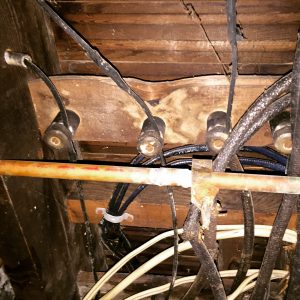So you’ve just found out the home you’ve fallen in love (or maybe already own?) has knob and tube wiring. Visions of The Money Pit dance in your head. Is this your future?
Questions about knob & tube wiring are common in Toronto–land of beautiful, old houses with equally beautiful old wiring. I started this section since it seems every house we’ve sold lately has had some K&T.
Knob & Tube Wiring: The Basics
Everyone is nervous about knob and tube wiring, but the reality is that it isn’t necessarily the problem it’s made out to be-it just depends on who you ask. Have a look at this video, which is about as exciting as knob-and-tube videos get (but has some good basic info and video of what it looks like):
Here’s what the Electrical Safety Authority has to say about the matter:
Knob and Tube Wiring in Residential Installations
Since January 2003 the Electrical Safety Authority has received an increasing number of questions about the safety of knob and tube wiring. In particular, purchasers or owners of older homes are finding that many insurers will not provide or renew coverage on such properties. In some cases, the insurance companies are requiring a total replacement of this wiring prior to providing insurance coverage.
 Knob and tube wiring, more recently referred to as open wiring, was a wiring method used in the early 1900s to 1940s in the residential sector. Over the years wiring installation practices have changed in the residential sector and knob and tube wiring is no longer installed; however, parts continue to be available for maintenance purposes. Existing knob and tube conductors concealed in walls, floor spaces, etc; supplying general lighting and receptacle circuits are permitted to remain in place if:
Knob and tube wiring, more recently referred to as open wiring, was a wiring method used in the early 1900s to 1940s in the residential sector. Over the years wiring installation practices have changed in the residential sector and knob and tube wiring is no longer installed; however, parts continue to be available for maintenance purposes. Existing knob and tube conductors concealed in walls, floor spaces, etc; supplying general lighting and receptacle circuits are permitted to remain in place if:
- They are protected by a 15-ampere fuse or circuit breaker; and
- No additional outlets have been added to the original installation so as to overload the circuit; and
- The conductors, where visible, appear to be in good condition.
- If your home has knob and tube wiring, we recommend that you follow these guidelines:
- Have a qualified electrical contractor check the “knob and tube” conductors in your existing installations for signs of deterioration and damage, or request a general inspection from ESA. The General Inspection report will identify visible electrical safety concerns in your electrical wiring.
- “Knob & tube” conductors should be replaced where exposed conductors show evidence of mechanical abuse and/or deterioration, poor connections, overheating, alterations that result in overloading, or if changes to wiring contravene any section of the Ontario Electrical Safety Code.
Homes with knob and tube wiring may not have the electrical capacity to meet today’s needs. As a result, homeowners have modified their electrical system with what the Electrical Safety Authority classifies as unsafe practices:
- Improper use of extension cords – using improperly rated extension cords, or using extension cords as permanent wiring;
- Improper fuse replacement – using 20 or 30 amp fuses to replace15 amp;
- Improper connections – adding receptacles and outlets on existing circuits or improperly connecting to the knob and tube wiring (this work should be done by a qualified electrician);
- Removing ground pins – ground pins on power bars or electrical equipment should not be removed to accommodate the two pin receptacles used in knob and tube wiring (2 pin to 3 pin are not permitted)
- Improper replacement of two pin receptacles. If you require a three-prong receptacle, only use a GFCI receptacle. Homeowners who are planning to modify their knob and tube wiring, or any other electrical wiring, should have the work performed by a licensed electrical contractor or electrician and arrange for an electrical inspection by Electrical Safety Authority.
Knob & Tube Wiring: Myths
- Knob & Tube wiring is unsafe.
- All knob and tube wiring must be disconnected and replaced.
- The Ontario Electrical Safety Code no longer recognizes knob and tube wiring as an acceptable wiring method.
Knob & Tube Wiring: Facts
- Knob & Tube wiring is safe, provided it is properly maintained by competent qualified people as outlined above.
- The Electrical Safety Authority, as well as the Ontario Electrical Safety Code, recognize and accept knob and tube wiring methods.
- The Ontario Electrical Safety Code 2002 edition contains rules that govern the installation of open type wiring methods (knob & tube). Rules 12-200 to 12-224 set out the minimum safety standards for the installation of open wiring, which may still be installed to this day.
Buying an old Toronto house comes with challenges…knob and tube wiring is one of the biggest.

ray says:
Thanks for the informative non biased post